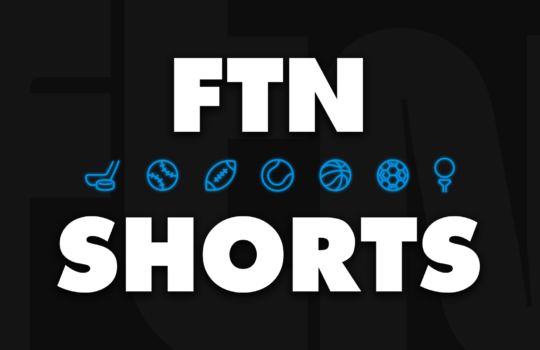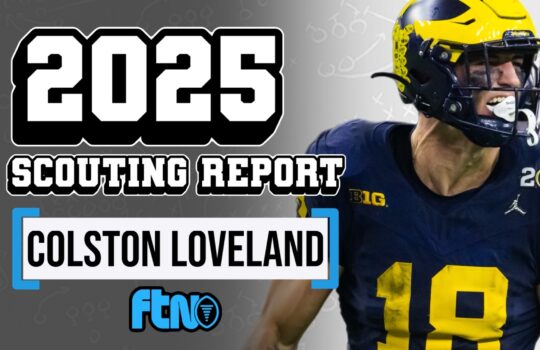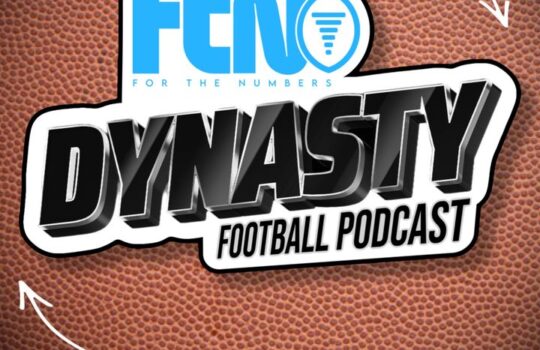
NFL training camps are around the corner and fantasy drafts are in full swing. We continue our ADP analysis at FTN, looking for players to target or fade based on draft data throughout the summer.
This article will focus on some of the players to target or avoid in fantasy drafts based on Underdog ADP. Keep in mind that ADP can be slightly skewed on Underdog thanks to the importance of stacking (both teams and Week 17 game stacks) in best ball.
Ryan Tannehill, QB, Tennessee Titans

Ryan Tannehill’s ADP was worth a conversation before the team signed DeAndre Hopkins to serve as its WR1 for the 2023 season. Tannehill is coming off his worst finish since joining the Titans (QB22) thanks to an injury that forced him to miss five games. Despite that, he was being drafted as the QB32 in Underdog, behind 49ers backup (third-stringer?) Trey Lance.
In reality, the Tannehill hate has gone too far. In four seasons with the Titans, the veteran quarterback has completed 66.9% of his passes while averaging 3,207.8 passing yards, 22.3 touchdowns and 8.3 interceptions per season. He’s also provided an adequate rushing floor since 2019, carrying the ball 175 times for 819 yards and 20 rushing touchdowns. Sure, he won’t be leading the league in pass attempts anytime soon, but he’s an efficient passer behind an improved offensive line that will now have Hopkins, Treylon Burks and Chigoziem Okonkwo in the passing game.
Tannehill will undoubtedly climb in the rankings in the coming weeks with Hopkins at his disposal. But even a modest increase in ADP will have him underpriced relative to his scoring with the Titans over his career. It isn’t too late to jump on board to grab a safe QB2 in the best ball and redraft leagues for 2023.
James Cook, RB, Buffalo Bills

There was plenty of hype in Buffalo when the Bills selected James Cook in the second round of the 2022 NFL Draft. Cook flashed explosiveness in a backfield timeshare with the University of Georgia throughout college, and many thought the rookie would immediately carve out a role as a pass-catcher in the NFL. Unfortunately, that didn’t happen.
Cook played in 16 games his rookie season, carrying the ball 89 times for 507 yards and two touchdowns while adding 21 receptions on 32 targets for 180 yards and one receiving touchdown. Cook had just one game with a snap share above 50% and just four games with double-digit touches during his rookie season. With Devin Singletary out of the equation, many hope that Cook will break out in his second season. Consider me skeptical about that potential outcome.
A lot of times, NFL teams will tell you what to expect through their moves in the offseason. The Bills let Singletary walk but still invested in the running back position by adding Damien Harris and Latavius Murray in free agency. Both players figure to take the bulk of early-down work and factor in heavily on the goal line (when the team isn’t using Josh Allen to punch in red-zone touchdowns). The Bills also didn’t cut Nyheim Hines after he failed to carve out a role on the Bills’ offense after a midseason trade with the Indianapolis Colts.
Even if Cook does emerge as a pass-catching back, it may be difficult for him to earn targets from a quarterback who historically pushes the ball downfield. Over the last three seasons, just 13.8% of Allen’s targets have gone to the running back position. Mobile quarterbacks typically don’t need to utilize the check-down options in the passing attack since they have the ability to run for yardage or open receivers up downfield with their ability to buy time.
Cook is currently going off the board as the RB30 in Underdog drafts with an ADP of 94.7. This seems very optimistic for a player who averaged just 6.8 touches per game in 2022 that lacks red-zone upside (unless the team specifically schemes up those touches).
Michael Pittman, WR, Indianapolis Colts
Michael Pittman wasn’t done any favors by the Colts’ quarterback musical chair trio of Matt Ryan, Nick Foles and Sam Ehlinger in 2022. Pittman earned the 11th-most targets in the NFL last season (141) but caught just 99 targets for 925 yards and four touchdowns. Despite the massive target share, Pittman finished as the WR20 in PPR leagues by averaging just 13.5 fantasy points per week.
Indianapolis invested in the quarterback position this offseason, grabbing Gardner Minshew in free agency before using the fourth overall pick of the 2023 draft on Florida’s Anthony Richardson. Still, fantasy managers remain skeptical of Pittman in drafts, selecting him as the WR34 with an ADP of 67.7. At first glance, this seems like the right call.
The Colts project to be an extremely run-heavy offense this season once Richardson takes the helm. The rookie quarterback is the greatest athlete we have ever seen at the position, but he started just 12 games in his Florida career, completing a paltry 53.8% of his passes. Richardson needs experience as a passer but will have an instant impact in the running game in an offense that will likely try to limit his passing to high-percentage (but low-yardage) throws with the occasional deep shot. That could mean a steady diet of slants for Pittman with more explosive players like Alec Pierce and rookie Josh Downs working to get open down the field. Add in a lingering hip injury that cost Pittman practice time during OTAs, and it makes sense that fantasy gamers haven’t bought into his role in the Colts passing attack.
Pittman’s WR34 ADP may seem modest to some, especially given his role as the Colts’ best receiver. But there are plenty of ways for Pittman to fall short this season and put up another middling year, making him a reasonable fade in fantasy drafts.
Sam LaPorta, TE, Detroit Lions
Finding mid- to late-round tight end production is essential when it comes to fantasy football. Fantasy gamers should be searching out above-average athletes at the tight end position who have a legitimate shot to finish first or second in targets on their team. One player who meets that criteria is Detroit Lions rookie Sam LaPorta.
LaPorta didn’t get a ton of recognition in Iowa’s low-volume passing offense, but he was extremely effective throughout his career. In the last two seasons, LaPorta caught 111-of-171 targets for 1,318 yards and four touchdowns. Over the last three seasons, LaPorta ran routes out of the slot on 32% of his passing snaps, and his 20 forced missed tackles were second in the nation last season. He is a dynamic weapon as a pass-catcher despite running routes on a run-heavy college offense. He was a second-round pick in the 2023 NFL Draft despite the limited production and finds himself in a Detroit offense starved for pass-catchers.
Fantasy managers can expect Amon-Ra St. Brown to lead the team in targets once again, but after that, the team’s primary pass-catcher seems murky. Jameson Williams will miss the first six games with a suspension. Jahmyr Gibbs will likely get pass-catching work out of the backfield but will undoubtedly split time with David Montgomery throughout his rookie season. That leaves players like Josh Reynolds, Marvin Jones and Kalif Raymond to soak up targets.
There’s a very realistic chance that LaPorta finishes as the team’s second-leading target in his rookie season and carves out a role in the red zone. That is upside worth shooting on, especially with a modest 165.3 ADP and TE20 price tag.
















































 New York Jets
New York Jets  New England Patriots
New England Patriots  Miami Dolphins
Miami Dolphins  Buffalo Bills
Buffalo Bills  Pittsburgh Steelers
Pittsburgh Steelers  Cleveland Browns
Cleveland Browns  Cincinnati Bengals
Cincinnati Bengals  Baltimore Ravens
Baltimore Ravens  Tennessee Titans
Tennessee Titans  Jacksonville Jaguars
Jacksonville Jaguars  Indianapolis Colts
Indianapolis Colts  Houston Texans
Houston Texans  Las Vegas Raiders
Las Vegas Raiders  Los Angeles Chargers
Los Angeles Chargers  Kansas City Chiefs
Kansas City Chiefs  Denver Broncos
Denver Broncos  Washington Commanders
Washington Commanders  Philadelphia Eagles
Philadelphia Eagles  New York Giants
New York Giants  Dallas Cowboys
Dallas Cowboys  Minnesota Vikings
Minnesota Vikings  Green Bay Packers
Green Bay Packers  Detroit Lions
Detroit Lions  Chicago Bears
Chicago Bears  Tampa Bay Buccaneers
Tampa Bay Buccaneers  New Orleans Saints
New Orleans Saints  Carolina Panthers
Carolina Panthers  Atlanta Falcons
Atlanta Falcons  San Francisco 49ers
San Francisco 49ers  Seattle Seahawks
Seattle Seahawks  Los Angeles Rams
Los Angeles Rams  Arizona Cardinals
Arizona Cardinals 










 Boston Celtics
Boston Celtics  Brooklyn Nets
Brooklyn Nets  Philadelphia 76ers
Philadelphia 76ers  New York Knicks
New York Knicks  Toronto Raptors
Toronto Raptors  Chicago Bulls
Chicago Bulls  Detroit Pistons
Detroit Pistons  Milwaukee Bucks
Milwaukee Bucks  Cleveland Cavaliers
Cleveland Cavaliers  Indiana Pacers
Indiana Pacers  Orlando Magic
Orlando Magic  Atlanta Hawks
Atlanta Hawks  Charlotte Hornets
Charlotte Hornets  Miami Heat
Miami Heat  Washington Wizards
Washington Wizards  Denver Nuggets
Denver Nuggets  Minnesota Timberwolves
Minnesota Timberwolves  Oklahoma City Thunder
Oklahoma City Thunder  Portland Trail Blazers
Portland Trail Blazers  Utah Jazz
Utah Jazz  LA Clippers
LA Clippers  Golden State Warriors
Golden State Warriors  Los Angeles Lakers
Los Angeles Lakers  Phoenix Suns
Phoenix Suns  Sacramento Kings
Sacramento Kings  Dallas Mavericks
Dallas Mavericks  Houston Rockets
Houston Rockets  Memphis Grizzlies
Memphis Grizzlies  New Orleans Pelicans
New Orleans Pelicans  San Antonio Spurs
San Antonio Spurs 










